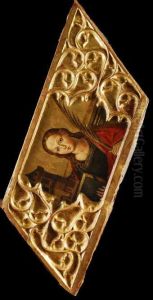Vicente El Viejo Macip Paintings
Vicente Macip, also known as Vicente Juan Macip or Vicente el Viejo ('the Elder') to distinguish him from his more famous son Juan de Juanes, was a Spanish painter of the Renaissance period. Born in La Font de la Figuera, Valencia, in 1475, his work is less well-known than that of his son, but he was a significant figure in the development of the Valencian school of painters.
Vicente Macip's life and work were largely centered in the region of Valencia. He was active during a time when the Renaissance style was taking root in Spain, and his work is characterized by the incorporation of Italian Renaissance influences into Spanish art. He was particularly influenced by the compositions and the use of perspective and chiaroscuro developed by Italian masters.
Not much is known about his training or early career, but it is believed that Macip might have traveled to Italy, like many artists of his time, to study the works of the Italian Renaissance. His career developed in a period that saw the transition from Gothic to Renaissance styles in Spain, and he played a role in this transformation in Valencian art.
Vicente Macip's works include altarpieces and religious paintings, which were common commissions during the period. He was adept at creating large-scale compositions for churches and religious institutions. His art is noted for its devotional quality and its detailed representation of religious iconography, which was essential for instructive purposes in the Counter-Reformation era.
Macip's legacy is somewhat overshadowed by the achievements of his son, Juan de Juanes, who is considered one of the most important Spanish painters of the 16th century. Juan de Juanes was heavily influenced by his father's work and would go on to refine and propagate the Renaissance style in Spain with even greater success. Vicente Macip died in 1545, leaving behind a body of work that would influence Valencian painters and contribute to the cultural heritage of Spain.
